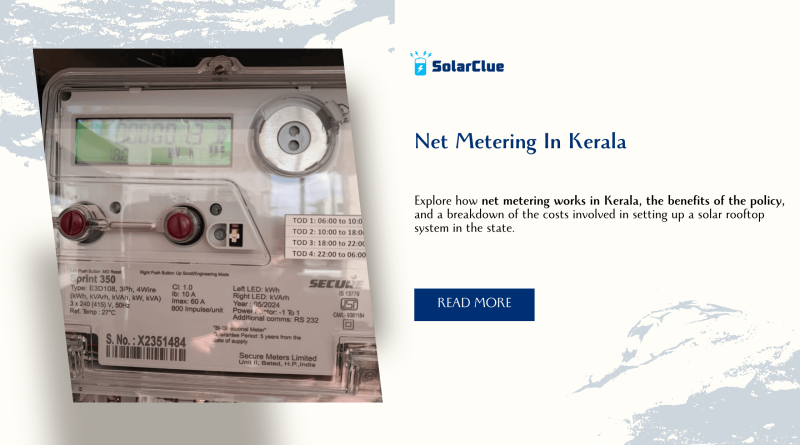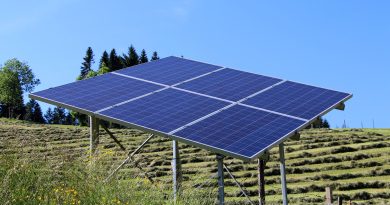Net Metering In Kerala
Kerala, a state known for its progressive policies on renewable energy, has implemented a Net Metering Policy to promote the use of solar power. This policy encourages residential, commercial, and industrial consumers to adopt solar rooftop systems, helping reduce electricity costs while also contributing to environmental sustainability. Kerala’s government, through its distribution companies, has made it easier for consumers to generate their own electricity, with any excess being exported to the grid for credits.
In this blog, we will discuss how net metering works in Kerala, the benefits of the policy, and a breakdown of the costs involved in setting up a solar rooftop system in the state.
Table of Contents
- 1 What is Net Metering?
- 2 Benefits of Net Metering in Kerala
- 2.1 1. Reduction in Electricity Bills
- 2.2 2. Environmental Benefits
- 2.3 3. Energy Independence
- 2.4 4. Financial Returns
- 2.5 Key Highlights of Kerala Net Metering Policy
- 2.6 How to Apply for Net Metering in Kerala
- 2.7 1. Check Eligibility
- 2.8 2. Select an Approved Vendor
- 2.9 3. Submit Application
- 2.10 4. Install Bi-Directional Meter
- 2.11 5. Inspection and Approval
- 2.12 6. Start Generating Energy
- 3 Estimated Cost of Net Metering System in Kerala
What is Net Metering?
Net metering is a billing mechanism that allows consumers with renewable energy systems, particularly solar, to export excess electricity generated by their systems to the grid. The exported electricity is recorded, and consumers earn credits, which can be used to offset future electricity consumption. Consumers are billed based on the net energy—the difference between the energy imported from the grid and the energy exported to the grid.
Net metering in Kerala aims to make solar power more accessible and affordable for consumers, reducing electricity bills and supporting the state’s shift toward cleaner energy sources.
Key Features of Kerala’s Net Metering Policy
1. Eligibility Criteria
- Consumer Types: Residential, commercial, industrial, and institutional consumers are eligible.
- System Size: Solar rooftop systems with a capacity ranging from 1 kW to 1 MW are allowed.
- Connection Type: Consumers must have a connection with the Kerala State Electricity Board (KSEB) or other local distribution companies.
2. Solar System Capacity
- The capacity of the solar system should not exceed the sanctioned load or contract demand of the consumer’s existing connection.
- The maximum allowable capacity for residential and commercial consumers is 80% of their sanctioned load.
3. Billing and Settlement
- A bi-directional meter is installed to record both the energy consumed from the grid and the energy exported back to the grid.
- Consumers are billed based on net energy, which is the difference between the energy imported and exported.
- Settlement Period: Energy credits are settled on a monthly basis, and any surplus credits are carried forward to the next billing cycle.
4. Installation and Maintenance
- Consumers must bear the cost of installing the solar rooftop system.
- The maintenance of the solar system, including cleaning and system checks, is the responsibility of the consumer.
- It is recommended to use approved vendors and certified installers to ensure compliance with KSEB standards.
5. Government Incentives and Subsidies
- The Ministry of New and Renewable Energy (MNRE) offers subsidies of up to 40% for systems up to 3 kW and 20% for systems between 3 kW and 10 kW.
- Kerala also encourages the adoption of solar systems by offering incentives for the installation of rooftop solar systems.
Benefits of Net Metering in Kerala
1. Reduction in Electricity Bills
By generating their own electricity, consumers can reduce their dependency on the grid. Any surplus energy exported to the grid earns credits that reduce future electricity bills, resulting in substantial savings.
2. Environmental Benefits
Net metering promotes the use of solar energy, a clean and renewable energy source, which helps reduce the state’s carbon footprint. By adopting solar power, Kerala can decrease its reliance on non-renewable energy sources like coal and natural gas.
3. Energy Independence
Solar energy allows consumers to be more energy-independent, reducing the risks associated with grid power shortages and rising electricity costs.
4. Financial Returns
The payback period for a solar system typically ranges between 5 to 8 years, after which the energy savings essentially provide free electricity for the remainder of the system’s lifespan, which can be 20-25 years.
Key Highlights of Kerala Net Metering Policy
| Aspect | Details |
|---|---|
| Eligible Consumers | Residential, Commercial, Industrial, Institutional |
| System Size | 1 kW to 1 MW |
| Maximum Solar Capacity | Up to 80% of sanctioned load |
| Billing Mechanism | Net metering with bi-directional meter |
| Excess Energy Settlement | Monthly credit for surplus energy exported to the grid |
| Meter Type | Bi-directional meter to track energy import and export |
| Subsidies | Up to 40% for systems up to 3 kW; 20% for systems between 3 kW and 10 kW |
| Connection | Must be connected to KSEB or local DISCOMs |
| Settlement Period | Monthly, with surplus credits carried forward |
| Energy Credit Validity | Credits can be carried forward to future billing cycles |
| Maintenance | Consumer is responsible for system maintenance |
| Government Incentives | MNRE subsidies and state-level incentives available for solar installations |
| Environmental Benefit | Promotes clean energy and reduces carbon emissions |
How to Apply for Net Metering in Kerala
1. Check Eligibility
Verify that your home, business, or institution meets the eligibility requirements for net metering in Kerala. Make sure your sanctioned load aligns with the capacity of the solar system you plan to install.
2. Select an Approved Vendor
Choose an approved vendor or certified installer to ensure that your system complies with KSEB’s technical standards. This is important for ensuring smooth integration with the grid.
3. Submit Application
Submit an application to the Kerala State Electricity Board (KSEB) for grid connectivity. Applications can be made online via the KSEB website or at your nearest KSEB office.
4. Install Bi-Directional Meter
A bi-directional meter must be installed to track both the energy consumed from the grid and the energy exported back to the grid.
5. Inspection and Approval
Once the system is installed, KSEB will inspect and certify the system before granting connectivity to the grid.
6. Start Generating Energy
After approval, your solar system will begin generating electricity, and you can start benefiting from the credits earned for excess energy exported to the grid.
Estimated Cost of Net Metering System in Kerala
The cost of installing a solar rooftop system under net metering in Kerala depends on factors like system size, equipment quality, and installation charges. Below is an estimated cost breakdown for 1 kW, 3 kW, and 5 kW solar systems in Kerala.
Estimated Cost for Solar System Installation in Kerala
| Component | 1 kW System | 3 kW System | 5 kW System |
|---|---|---|---|
| Solar Panels | ₹25,000 – ₹40,000 | ₹75,000 – ₹1,20,000 | ₹1,25,000 – ₹2,00,000 |
| Inverter | ₹6,000 – ₹12,000 | ₹18,000 – ₹36,000 | ₹30,000 – ₹60,000 |
| Bi-Directional Meter | ₹5,000 – ₹10,000 | ₹5,000 – ₹10,000 | ₹5,000 – ₹10,000 |
| Mounting Structure | ₹1,500 – ₹3,000 | ₹4,500 – ₹9,000 | ₹7,500 – ₹15,000 |
| Wiring and Cabling | ₹2,000 – ₹4,000 | ₹6,000 – ₹12,000 | ₹10,000 – ₹20,000 |
| Installation and Labor | ₹5,000 – ₹8,000 | ₹10,000 – ₹15,000 | ₹15,000 – ₹25,000 |
| Total Estimated Cost | ₹44,500 – ₹77,000 | ₹1,18,500 – ₹2,02,000 | ₹1,92,500 – ₹3,30,000 |
Conclusion
Kerala’s net metering policy offers a simple and cost-effective way for consumers to generate their own electricity, reduce electricity bills, and contribute to environmental sustainability. With government subsidies and the long-term financial benefits of solar energy, it is an excellent time for residents and businesses in Kerala to invest in solar rooftop systems.
Ready to Save on Electricity Bills with Solar Power?
With Net Metering, you can drastically reduce your electricity costs by generating your own solar power and sending any excess back to the grid. It’s time to harness the sun’s energy and make a positive impact on both your wallet and the environment!
At SolarClue, we make the transition to solar simple, efficient, and affordable. Whether you’re a homeowner, business, or institution, our team of solar experts will guide you through the process—from installation to maintenance—so you can start saving from day one.
🌞 Take the first step towards energy independence today!
🔋 Get your solar consultation now!
Contact SolarClue or call us at +91-888-4444-830 to explore the best solar solutions for your home or business.
Go Solar. Save More. Power Your Future with SolarClue!
FAQs
1. What is the maximum capacity for a solar rooftop system under net metering in Kerala?
The maximum capacity for a rooftop solar system is 1 MW, but it should not exceed 80% of the consumer’s sanctioned load.
2. How does net metering benefit consumers in Kerala?
Net metering allows consumers to offset their electricity consumption by using self-generated energy. Any surplus energy exported to the grid earns credits, reducing future bills.
3. What government subsidies are available for solar installations in Kerala?
The MNRE offers up to 40% subsidy for systems up to 3 kW and 20% for systems between 3 kW and 10 kW.
4. How long is the payback period for a solar system in Kerala?
The payback period typically ranges from 5 to 8 years, depending on system size, electricity usage, and government incentives.
5. Is net metering available for businesses in Kerala?
Yes, businesses, industrial, and institutional consumers are eligible for net metering under Kerala’s policy.




